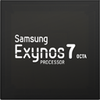Samsung Exynos 7870 Octa vs Qualcomm Snapdragon 630 vs Samsung Exynos 7880
Samsung Exynos 7870 Octa
► remove from comparison
The Samsung Exynos 7 Octa is a 64-bit SoC for mainstream smartphones and tablets (usually Android based). It was announced in February 2016 and integrates eight Cortex-A53 cores, which are manufactured in a modern 14-nm process. Compared to the previous 28-nm-SoCs, the performance was increased and the power consumption is 30 % lower according to Samsung. The integrated LZE Cat.6 modem reaches transfer rates of up to 300 Mbps (downstream) and 50 Mbps (upstream). The dual-channel memory controller supports LPDDR3-1866 RAM.
The integrated graphics adapter is an ARM Mali-T830 MP1 (core clock of 700 MHz according to Wikipedia). Besides OpenGL ES 3.2, it also supports OpenCL 1.2 as well as DirectX 11 (FL 9_3). The performance is sufficient for common Android games from 2016 at medium details.
Qualcomm Snapdragon 630
► remove from comparison
The Qualcomm Snapdragon 630 (SDM630) is a mid-range octa-core SoC with eight ARM Cortex-A53 CPU cores at up to 2.2 GHz, an Adreno 508 GPU, a LPDDR4-2666 memory controller (1333 MHz) and a X12 LTE (Cat 12/13, 300 Mbps down, 150 Mbps up) modem. Furthermore, the chip supports 802.11ac WiFi and Bluetooth 5.0. It is manufactured in 14nm FinFet. The processor performance should similar to the older Snapdragon 626 which offers similar clock speeds. Compared to the 626, the 630 however supports faster memory and offers faster LTE, Wifi and Bluetooth standards.
Samsung Exynos 7880
► remove from comparison
The Samsung Exynos 7 Octa 7780 is a 64-bit SoC for mainstream smartphones and tablets (usually Android based). It was announced early 2017 and integrates eight Cortex-A53 cores clocked at up to 1.9 GHz. It is manufactured in the modern 14 nm FinFET process at Samsung and integrates an LTE Cat 7 modem. The (dual channel?) memory controller supports LPDDR4 RAM.
Additionally, the SoC integrates GPS, GLONASS and Baido positioning systems, UHD / HEVC (H.265) video de- and encoding and UFS 2.0 / eMMC 5.1 storage.
| Model | Samsung Exynos 7870 Octa | Qualcomm Snapdragon 630 | Samsung Exynos 7880 | ||||||||||||||||||||||||||||||||||||||||||||||||||||||||||||||||||||||||||||||||
| Codename | A53 | Cortex-A53 | A53 | ||||||||||||||||||||||||||||||||||||||||||||||||||||||||||||||||||||||||||||||||
| Series | Samsung Exynos | Qualcomm Snapdragon | Samsung Exynos | ||||||||||||||||||||||||||||||||||||||||||||||||||||||||||||||||||||||||||||||||
| Series: Exynos A53 |
|
|
| ||||||||||||||||||||||||||||||||||||||||||||||||||||||||||||||||||||||||||||||||
| Clock | 1600 MHz | 2200 MHz | 1900 MHz | ||||||||||||||||||||||||||||||||||||||||||||||||||||||||||||||||||||||||||||||||
| Cores / Threads | 8 / 8 | 8 / 8 | 8 / 8 | ||||||||||||||||||||||||||||||||||||||||||||||||||||||||||||||||||||||||||||||||
| Technology | 14 nm | 14 nm | 14 nm | ||||||||||||||||||||||||||||||||||||||||||||||||||||||||||||||||||||||||||||||||
| Features | ARM Mali-T830 GPU, 8x Cortex-A53 1.6 GHz, LTE Cat.6, 14 nm, dual-channel memory controller LPDDR3-1866 | Adreno 508 GPU, 802.11ac Wave 2 Wi-Fi, Bluetooth 5.0, LTE Cat. 13 (uplink) Cat. 12 (downlink), Dual-Channel LPDDR4 1333 MHz Memory Controller | ARM Mali-T830 MP3 GPU, 8x Cortex-A53 1.9 GHz, LTE Cat. 7, 14 nm, LPDDR4 memory controller, UHD 40fps recording and palyback with HEVC | ||||||||||||||||||||||||||||||||||||||||||||||||||||||||||||||||||||||||||||||||
| iGPU | ARM Mali-T830 MP1 (700 MHz) | Qualcomm Adreno 508 | ARM Mali-T830 MP3 | ||||||||||||||||||||||||||||||||||||||||||||||||||||||||||||||||||||||||||||||||
| Architecture | ARM | ARM | ARM | ||||||||||||||||||||||||||||||||||||||||||||||||||||||||||||||||||||||||||||||||
| Announced | |||||||||||||||||||||||||||||||||||||||||||||||||||||||||||||||||||||||||||||||||||
| Manufacturer | www.samsung.com | www.qualcomm.com | www.samsung.com |
Benchmarks
Average Benchmarks Samsung Exynos 7870 Octa → 100% n=13
Average Benchmarks Qualcomm Snapdragon 630 → 108% n=13
Average Benchmarks Samsung Exynos 7880 → 114% n=13
* Smaller numbers mean a higher performance
1 This benchmark is not used for the average calculation












